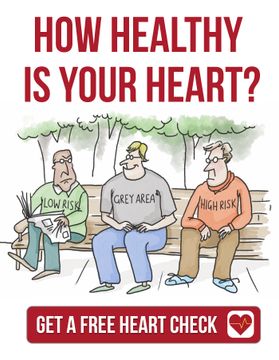JOIN OUR HEALTHY HEART MEMBERSHIP HERE: https://healthyheartnetwork.com/page/starter
Welcome to Doctor Warrick's Podcast Channel. Warrick is a practicing cardiologist and author with a passion for improving care by helping patients understand their heart health through education. Warrick believes educated patients get the best health care. Discover and understand the latest approaches and technology in heart care and how this might apply to you or someone you love.
Hi, my name is Doctor Warrick Bishop, and I'd like to welcome you to my podcast and videocast station, and of course, welcome you to the Healthy Heart Network. Today, I'd like to share with you a case, a story about a man I saw this last week. This gentleman was in his early 60s. He's a very fit, slim, and active man who has looked after himself over the years. He does exercise regularly, and he is keen to make sure that he has the best heart health. We imaged his heart. We did a C.T. scan about eight years ago, and we figured out from that scan that he carried a pretty high risk of coronary disease. At that stage, we elected to put him on surveillance stress-testing because there were areas that may well have progressed, and we wanted to be clear that that wasn't occurring. At the same time, when we saw there was a lot of plaque in his arteries, we also decided to do some novel blood testing, and one of the things that we checked for was Lipoprotein Small A or Little A.
Lipoprotein Small A sounds like a heck of a mouthful, but in very simple terms, it's a cholesterol parcel that goes around in the bloodstream. We think of LDL cholesterol as a parcel that goes around in the bloodstream, and cholesterol doesn't float through the blood by itself; it's wrapped up in little proteinous balls. Well, the Lipoprotein Small A proteinous ball is one that causes mischief where it goes. It's more likely to cause inflammation, it's more likely to cause clotting. It's a link, and it has been linked to an increased likelihood of calcification within the arteries and coronary disease. It has also been linked to narrowing of the aortic valve.
So, Lipoprotein Little A. It's another carrier of cholesterol around the bloodstream, but one that seems to cause some mischief. It's an important one to know because it can run in families. And we do sometimes treat people with nicotinic acid, which is a B-Group Vitamin to try and lower that Lipoprotein Little A level. It turns out, we actually put this patient on Lipoprotein Little A reduction using nicotinic acid. We also treated him with a statin because his cholesterol was on the higher side. Well, this patient had come along for a number of years and just this most recent stress test, we put through its paces in a pink exercise. The electrical activity of his heart as we were monitoring it changed altogether. He developed a complete change in the way the electricity moved through the bottom part of his heart. Now, that means instead of having little narrow spikes on his ECG, they became broad, ugly-looking spots on his ECG. For us cardiologists, we would call that a broad complex tachycardia. And for us cardiologists, that's an emergency. Until proven otherwise, we call that VT or ventricular tachycardia, and people can die from that.
We stopped the test immediately, put this patient on the bed, we checked out his heart, we watched everything that was going on, I scanned his heart because that was part of what we were doing, everything seemed to settle down and I had a suspicion that this may not have been a critical, bad electrical-driven problem, because our concern is, is there a narrowing in the arteries that limits the blood flow to the heart that leads to irritability of the heart muscle and throws the heart into this potentially lethal rhythm? It didn't look like that. This didn't look like a man who was suffering a bad lack of blood flow to the heart. "Bad ischaemia" is the term we use. Ischaemia meaning a lack of blood flow.
My thought was, "we should re-scan him and look at his C.T. scan," which we did. It turns out that, when I caught up with him this week, we found that his calcium score was really high. It was actually over 1000. It was about 300-400 when we saw him eight years ago. So, his calcium score was now over 1000. His calcium score percentile was at the 90th percentile. So if we were to take 100 men his age, he was in the worst 10. So, his calcium score was high; it was over 1000. His percentile was high. In normal terms, this would mean disaster.
But we do two things as part of our CT evaluation. The first is to look with non-contrast, no injection of dye, just looking at the calcium. And I've just told you what that showed. But the other thing that we do is we look at what the arteries looked like by injecting contrast and getting more information. In this particular man's case, when we did that, the really interesting thing was there wasn't any evidence of cholesterol-dominant plaque in there. There was no soft, non-calcific plaque; no soft, cholesterol-dominant plaque. The plaque that we are most concerned about because it is that soft, cholesterol-dominant plaque that can rupture and cause a blockage and a heart attack.
So, here's an interesting thing. This gentleman has been on his cholesterol-lowering agent for eight years, who took some Niacin early on in the piece, and who exercises regularly, has arteries that certainly have a lot of calcification, and in normal situations, that calcification, both the absolute score and the percentile, would be enough to make us very, very concerned. But in his particular situation, because of this complete lack of non-calcific plaque or cholesterol-dominant plaque; the fatty soft stuff, because he had none of that, his arteries look relatively inert.
So, I was able to say to this man, that probably through his exercise, through his statin therapy, through some of the nicotinic acid or Niacin he'd been taking, he'd been able to turn the soft plaque into calcific plaque, which is more stable and more inert in the arteries. I think this supported my feeling that the broad complex tachycardia, or the irregularity if the rhythm is unlikely to represent poor blood flow to the muscle of the heart, and more likely to represent a minor electrical abnormality.
This gentleman will continue on his regular surveillance stress-testing. He is restarting his nicotinic acid. We are going to keep his cholesterol under control, but a really interesting story where there is a high calcium score, a high calcium score percentile but the features, when we look at the arteries in more detail, really don't look that bad. We won't change our therapy; we'll keep doing exactly what we're doing, but I can give that man some reassurance that right at the moment, things look pretty good.
OK, well I hope that was a really interesting story. I hope you found it interesting and informative. If you've got any questions, please drop us a note. We'd love to hear from you. If you have any suggestions for any other topics, please let us know. So, for now, I'm going to say goodbye. I'm going to wish you the very best. And until next time, please don't die from a heart attack. Goodbye.
You've been listening to another podcast from Dr. Warrick. Visit his website at drwarrickbishop.com for the latest news on heart disease. If you love this podcast, feel free to leave us a review.
Check out my book at http://drwarrickbishop.com/books/









